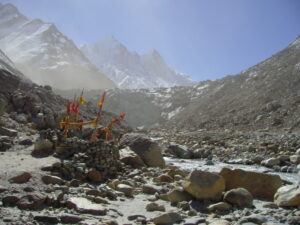Facts and statistics about River Ganga are important as the river itself is important to India. The Ganges or River Ganga is important because of its sacredness. And it also provides a livelihood for about 4 hundred million people.
Let’s dive into the importance of the river Ganga by learning its facts and statistics!

River Ganga, also known as…
RIVER GANGES

Origin of River Ganga
River Ganga originates in the Northern regions of the Himalayan Mountains. It originates from the Gomukh at the base of the Gangotri glacier in Uttarakashi in Uttarakhand.
The water of River Ganga flows from the melting of this glacier. The river is 2,500 kilometers long making it the longest river in India.
The Gangotri glacier is the largest glacier in the Himalayas with a volume of 27 cubic kilometers.
This water from the melted glacier then converts into the water of River Bhagirathi.
Accordingly, when the water of River Bhagirathi flows down the Himalayas, it further connects to River Alaknanda.
Thus, the connection of River Bhagirathi and River Alaknanda forms the Ganges River.

River Ganga and its tributaries
The tributaries of the River Ganges originate from countries such as Bangladesh, Nepal, and China (Tibet).
The most important tributaries of River Ganga include- the Ramaganga, the Gomti, the Yamuna, the Ghagra, the Burhi Gandak, the Kosi, the Son, and the Mahananda.
In West Bengal’s Farakka region, it is divided into 2 important rivers. Firstly, River Padma which flows through Bangladesh, and River Bhagirathi which flows through West Bengal.

River Ganga: the lifeline of India
Running through Northern parts of India, the river Ganges is the lifeline of India.
Termed sacred by Hindus, the river Ganga provides livelihood to the people who live in the Ganges River Basin.
Known for its rich nutrient sediments which deposit during her flow, enriches the shores with fertile soil which helps civilization at a great level.
States which it flows through
Statistics state that 79% of River Ganga’s basin lies in India.
It covers 4 countries with 11 states of India.
It flows through densely populated areas. Such as Uttarakhand, Uttar Pradesh, Madhya Pradesh, Rajasthan, Haryana, Himachal Pradesh, Chhattisgarh, Jharkhand, Bihar, West Bengal, and Delhi.
River Ganga is a source of water for many humans as well as animals who depend on it for their survival.
The particular river also provides water for irrigation, bathing, fishing, and also for religious purposes.

History of River Ganga
River Ganga holds a sacred place in India wherein the Hindus devote her as Mother Ganga or Ganga Maiya.
In Hindu mythology, the birth of the River Ganga marks Gomukh.
Consequently, there is a temple on River Ganges at Gangotri. This temple is famous as Chota Char Dham temple.
River Ganga, worshipped as the goddess of forgiveness holds an important position in India. Hinduism believes that bathing in Ganga would forgive them for all their sins and help them to attend salvation.
Since the Vedic age, River Ganga holds the title of sacredness.
According to history, River Ganga shares its importance with ancient imperial cities like Calcutta, Kampilya, Baharampur, Murshidabad, Patna, Kashi, Pataliputra, and Kannauj.

Facts and statistics about River Ganga
Firstly, River Ganga, after traveling through Northern India then empties itself into the Bay of Bengal.
Secondly, at the mouth where the River Ganga empties into the Bay of Bengal, forms the Ganges River Delta which is the largest river delta in the world. Known as Sunder-bans.
Sunder-bans declared as a World Heritage Site by UNESCO in 1997 is a home of many species (the famous Bengal Tiger included). It covers more than 1, 05,000 sq. kilometers which are 41,000 square miles.
Thirdly, when River Ganga connects with River Brahmaputra and River Meghna, it forms the Ganges-Brahmaputra-Meghna (GBM) river basin. GBM is one of the largest river systems in the world.
Fourth, with rich biodiversity, it includes aquatic plants, 90 amphibians, and more than 140 fish species.
These include the famous Gangetic Dolphin, 3 species of Otters, endangered Gharial, Indian marsh crocodile, and 12 species of freshwater turtles.
Sixth, according to data, River Ganga is the 5th most polluted river in the world.
Seventh, it is also rich in anti-bacterial properties. A critical study of the Ganges water shows that it is capable of decomposing organic waste 25 times faster than other rivers.
It also contains 25 times more oxygen which goes through a natural process of purifying itself.
Also in a study, the bacteria which resulted in Cholera could not survive in the Ganga for more than 3 hours.
Eighth, the shifting of the Ganga is not a new matter but in the past few decades, it has shifted its original course by 500 meters in Haridwar. Which is a matter that needs attention.
Ninth, River Ganga is the location of the famous Kumbh Mela which dates back its history to the 7th century.
Kumbh Mela is a ritual that occurs after every 3 years with 100 million people. Hindu pilgrims from around the world gather and perform rituals by bathing in the river.
Taking a bath is a way of purification of body and soul which washes away bad karma.
Tenth, due to Kumbh Mela, River Ganga holds the position of largest human gathering too.

Pollution level in River Ganga
By the end of 2007, River Ganges was declared the 5th most polluted river in the world despite it having religious as well as economic importance.
With the growing industrial waste and tonnes of plastic dumped into it, we could say that we are killing the river faster than its speed of purifying itself.
The tremendous amount of pollution screams the alert of danger to many in-and-around species.
The water of Ganga in Rishikesh gives a picture of its pure and clear form but in Varanasi, the river gives a picture of death!
Indians show a strange way of respecting the things that they worship. Cleaning of feat and body in the name of devotion, disposing of ashes in the name of salvation, and dumping flowers and other ritual stuff in the name of worship. Does this even sound pure?
However, the government has launched several projects to maintain and clean the river but have failed miserably. On the other hand, governance alone can’t solve the problem but you and I as a responsible crowd can.


